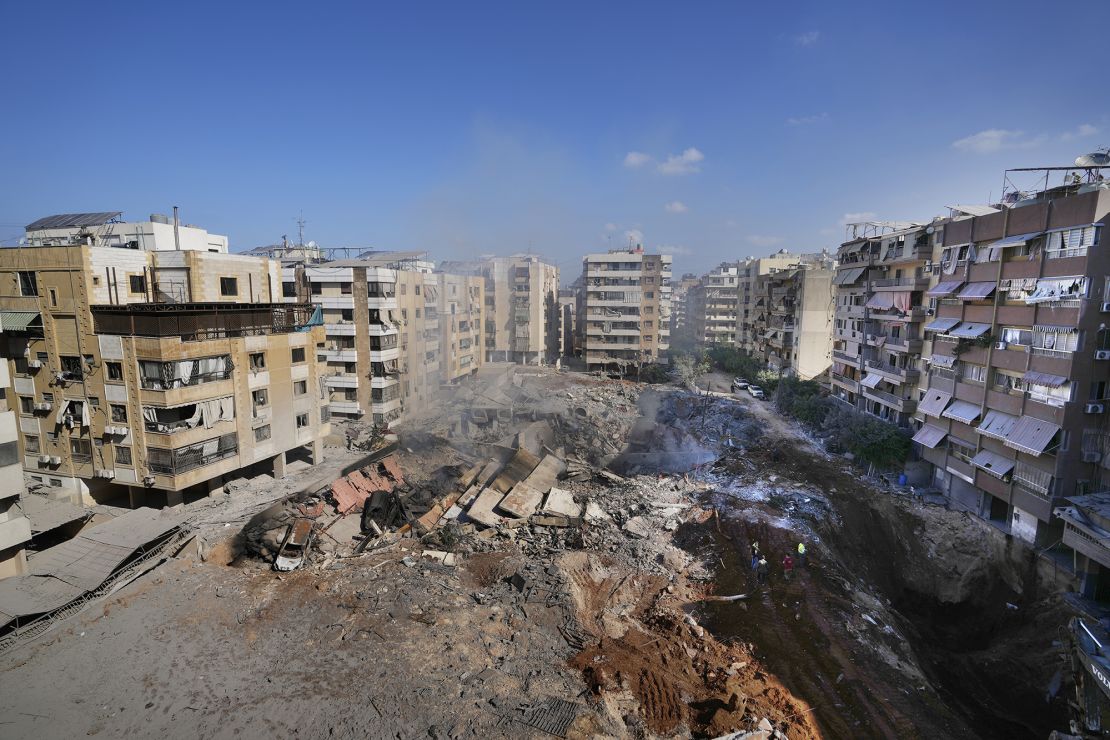CNN
—
American-manufactured 2,000-pound bombs were likely used in the Israeli attack that killed Hezbollah’s leader, Hassan Nasrallah, in Beirut on Friday night, according to a review of footage showing the operation and its aftermath by CNN and munitions experts.
A video published by the Israeli military on Saturday showed jets it said were used to carry out the attack carrying at least 15 2,000-pound bombs, including the US-made BLU-109, according to Trevor Ball, a former senior explosive ordnance technician for the US Army who reviewed the footage for CNN.
The bombs, known colloquially as “bunker busters” for their ability to penetrate deep underground before they detonate, were also fitted with the US-made Joint Direct Attack Munition (JDAM) – a precision guidance kit that converts unguided, or “dumb” bombs, into “smart” munitions that can precisely strike a target – according to Ball. On one plane fitted with bombs, pictured taking off in the video, Ball identified at least four as BLU-109s with JDAM kits.
Other types of large bombs may have been used in the operation, Ball added, but only the BLU-109s were visible in the footage. The munitions contain 535 pounds of explosives, significantly less than MK84s, another type of 2,000-pound bomb frequently used by the Israeli military. “BLU-109s give up explosive weight to be able to penetrate targets better than a MK84,” Ball said.
Video and imagery that CNN geolocated to the scene of the attack in Beirut’s southern suburbs, known as Dahiyeh, show a large, deep crater, surrounded by rubble from the destroyed buildings. A CNN analysis of video and satellite imagery confirmed four multistory apartment buildings were leveled in the attack.

Two senior Israeli defense officials told the New York Times that 80 bombs were used in the attack on Nasrallah. Ball told CNN that number was plausible but that it was difficult to tell based on available imagery of the crater alone. “It’s possible there were more similar craters that the building debris collapsed into and filled. It’s also unknown how deep and extensive any underground facilities were. That makes it extremely difficult to reliably estimate the number of munitions used,” he said.
Justin Bronk, a senior research fellow for air power and technology at the Royal United Services Institute in London, who also analyzed footage for CNN, said that the Israeli Air Force planes were carrying JDAM guidance kits, and that the crater left behind following the strike was consistent with the use of 2,000-pound BLU-109 bombs.
“[It] fits with the strike profile and the penetrating fuze settings and large warhead required to produce that sort of crater,” Bronk said. He added that the combination of BLU-109 bomb and JDAM kit were “what you’d expect for going after a buried, hardened target like that.”
The Israeli military did not release footage showing the moment it dropped the bombs, but videos circulating on social media on Friday showed huge explosions in Dahiyeh, where the strike was carried out on Nasrallah’s underground headquarters. Bronk told CNN that the numerous smoke plumes seen in one of the videos was consistent with multiple near-simultaneous impacts of 2,000-pound bombs, which have fuzes set to detonate underground.
Addressing reporters Saturday, Brig. Gen. Amichai Levin, commander of Israel’s Hatzerim Airbase, said that “dozens of munitions hit the target within seconds with very high precision,” adding that was what was “required to hit this deep underground.”
The Israeli military has repeatedly used 2,000-pound bombs during its deadly campaign in Gaza. Weapons and warfare experts blame the extensive use of such heavy munitions for the huge death toll.
Israel’s campaign in Gaza has killed more than 41,500 Palestinians and wounded more than 96,000 others, according to the latest figures from the health ministry there. Israel launched its ground offensive and aerial bombardment of the strip in response to the Hamas-led attack on October 7, in which militants killed around 1,200 people and took 250 others hostage.
The use of 2,000-pound bombs, which are mostly manufactured by the US, can cause high casualty events in part due to the enormous scale of their impact. The weapon’s blast, or lethal fragmentation radius – an area of exposure to injury or death around the target – is up to 365 meters (about 1,198 feet), or the equivalent of 58 soccer fields.
In May, the Biden administration said it had paused a shipment of the bombs to Israel over concerns of their potential use in the Rafah incursion and their risk to civilian harm.
Israel’s strikes in Lebanon continued at pace over the weekend, killing more than 100 people and wounding more than 350 others in the country on Sunday. The Israeli military said it was striking Hezbollah, including in attacks by fighter jets on about 45 targets near a village in southern Lebanon.
At least 12 locations in Beirut were struck between Friday and early Monday morning, according to CNN analysis. One attack took out a floor in an apartment building next to the city’s Cola intersection, a major transportation hub in central Beirut, marking the first time a location within the capital’s limits has been hit in nearly a year of conflict.

